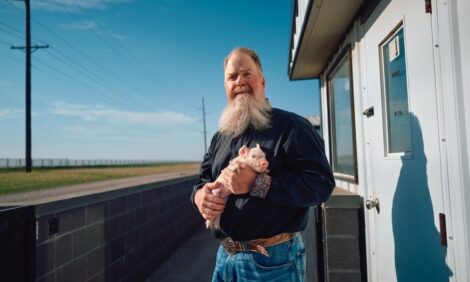



What's happening to UK Pig Production?
A rush for the exit or an orderly retreat? - This month’s Strak report (March 2002) takes a look at the price and slaughterings data for The UK pig herd in an attempt to discover if producers are heading for the exit door or just adjusting their sown numbers after FMD’s distractions.|
Dr John Strak

Dr Strak's views on the UK and global pig markets are produced in Whole Hog every fortnight. For more details click the link at the foot of the article. |
My price chart clearly shows that all the price pressure is downwards - the cycle is trying to turn down all the time. Even if UK prices turn up by Easter this seasonal effect is unlikely to alter the fundamental position of the pig market.
The euro’s weakness and the state of world pig supplies are reinforcing this tendency. I wrote last October that, "..this is not the time to expect an upturn in the pig price cycle" and the winter has proved this observation correct.
In the last 11 years the UK pig price has only twice reached a lower level that it has seen at the end of the first six weeks of 2002. Those two previous years were 1999 and 2000.
However, in early 1999 the underlying price cycle was reaching its nadir, and in early 2000 it was well on its way upwards. In 2002, by contrast, the cycle appears to have peaked.

Sow slaughterings were badly affected by FMD in 2001 and the confirmed June 2001 census figure from DEFRA indicates that the breeding herd size was 598,000 at that point. This is slight increase on the previous census figure and, in my view, reflects the constraints on movement and slaughter of old sows rather than any genuine desire to increase herd size by producers.
Slaughter rates were down during 2001 but in early 2002 have started to show significant increases.

Indeed, sow slaughterings at this time are probably running at rates similar to those seen in 1999 and 2000 when producers were rushing for the exit at a time of low prices which persisted much longer that anticipated.
The average weekly sow kill in 2002 is now running at just under 6,500 per week. Slaughter numbers were higher in 1999 and 2000 but the total herd size was much higher in those years too.
If producers are slaughtering sows at the same rate in 2002 as they were in early 2000 the 2002 herd size could get as low as 500,000 sows and boars. That could be termed a rush for the exit. The key statistic to watch now will be gilt retentions. If they increase there is just a chance that the herd will stabilise at c. 550,000 in 2002. That would be an orderly retreat.
The long run trend and cycle of sow slaughterings shown in the chart illustrates the upward turn in the slaughterings data in the last few months. This upward turn has probably been held back by the FMD outbreak but the move out of breeding pigs will not be delayed any longer.
If the sow slaughter data follow previous form we can expect to see average weekly sow slaughter levels of 5,000 head for the rest of this year. This may not seem much when you look at previous absolute levels but, in comparison with past periods, the UK herd is much smaller and these relatively high slaughter rates are the basis for my view that we could see the total UK herd below 500,000 by the end of 2002.
Producers often ask me to say what I expect to happen to the national herd and,as you can see from the above, I have tried to say what I expect to happen next.
Orderly retreat or rush for the exit is the choice I see before the industry at the beginning of 2002. One thing is for sure, this is not the time for advancing on all fronts. See you next month
Source: Whole Hog, April 2002






